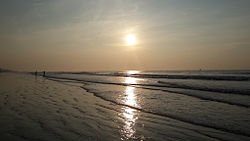Coastal India
Region bordering the Indian coastline From Wikipedia, the free encyclopedia
Coastal India is a geo-cultural region in the Indian subcontinent that spans the entire coastline of India.[1]
Indian total coastline is estimated to 11,098 km.[2]
Gujarat has the longest coastline at 1,600 km. Tamil Nadu comes second with 1,076 km. Andhra Pradesh comes third with 975 km. Maharashtra has a coastline of 720 km. This is the fourth longest coastline in India, and after Kerala, it has a coastline of 510 km, making it the fifth longest.[3]
Coastal states are Gujarat, Maharashtra, Goa, Karnataka, Kerala, Tamil Nadu, Andhra Pradesh, Odisha and West Bengal.
Other coastal union territories are Puducherry, Andaman and Nicobar Islands, Dadra and Nagar Haveli and Daman and Diu, Lakshadweep.




Sea trade and intermingling
A thriving trade existed between the Mediterranean world and Coastal Indian regions [4][5][6][7] This led to significant intermingling between the people of Coastal India and the west asian world, particularly along the South West Indian Coastline along the Arabian Sea. Several west Asian communities have also settled and become part of the diversity of coastal south west India. These include the Parsis,[8] Bohras[9] and Baghdadi Jews[10] in the westernmost region, The descendants of west asian and mediterranean traders like The Bearys of Kanara region and the Mappilas [11] along Malabar region, and the cochin jews[4][5][6][11][12][13][14] and Syriac Nasranis[4][5][6][11][12][13][14] along the southernmost region of South India. The Chola Empire established vast Tamil influence across South East Asian region [15][16][17] across Indonesia, Java, Bali and Sumatra. This brought South Indian Heritage to Cambodia, Indonesia and Bali where the Balinese Hindu traditions still thrives. This also lead to intermingling between coastal India and the south east Asia particularly in the South eastern Cholamandalam coastline along the Bay of Bengal.
Heritage
Summarize
Perspective
The linguistic diversity of Coastal India includes languages of the Dravidian language family including Malayalam, Tamil, Telugu, Tulu, Beary and Kannada; languages belonging to the western zone of Indo Iranian language families including Gujarati, Marathi, Konkani, languages belonging to the central zone of the Indo-Iranian language families including Urdu and Persian and languages belonging to the eastern zone of Indo Iranian language family including Odia and Bengali. The region also has speakers of Semitic languages like Arabic, Hebrew and Aramaic. The common elements of the people of coastal India includes cuisine that consists of agrarian and coastal products and clothing that involves long flowing drapes with bare midriff for both men and women suited for humid and warm climate.[18] Throughout coastal India women wear drapes called saree in various styles.[18] In the western corner of the region the drapes are called as Dhoti for men.[18] and Chaniya choli for women,[18] further southwards the drapes are called as lungi or mundu for men.[18] and veshti for women.[18] Towards the southernmost tip of coastal south western India the social system of inheritance was once matrilineal.[18][19][20][21][22] There are various festivals celebrated in the coastal states centered on deities.[23]
Gallery
- Sunrise Digha Beach.
- Puri Beach as it viewed from a light House.
- Marina Beach's Bird eye view.
- Varkala Beach, Kerala is the highest Cliff beach in India.
- Om Beach is known as one of seven important centers of pilgrimage in Hinduism.
- Palolem Beach is a tourist destination in South Goa.
- Somnath Temple with Veraval Beach in the background.
- Promenade Beach at Night.
- Wandoor Beach is an attraction of Mahatma Gandhi Marine National Park.
- Minicoy is an island in Lakshadweep.
- Sunset at Devka Beach, Daman.
See also
References
Wikiwand - on
Seamless Wikipedia browsing. On steroids.












